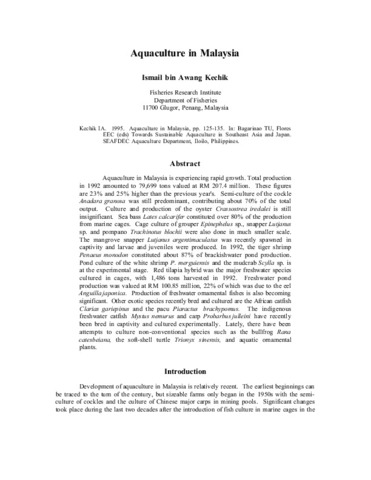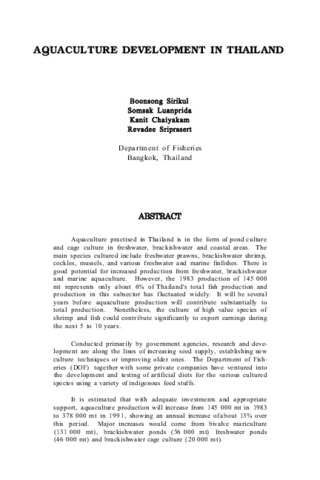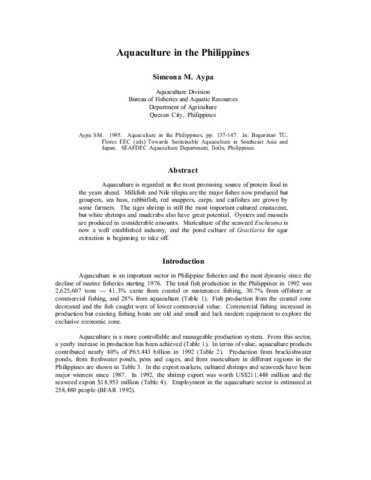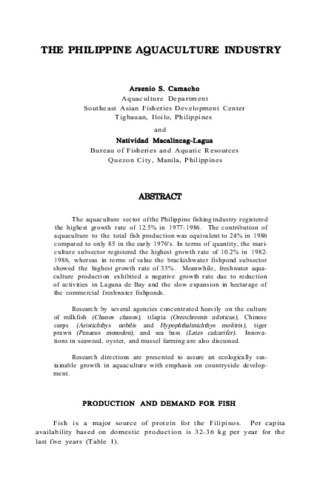Aquaculture in Malaysia
Share
Abstract
Aquaculture in Malaysia is experiencing rapid growth. Total production in 1992 amounted to 79,699 tons valued at RM 207.4 million. These figures are 23% and 25% higher than the previous year's. Semi-culture of the cockle Anadara granosa was still predominant, contributing about 70% of the total output. Culture and production of the oyster Crassostrea iredalei is still insignificant. Sea bass Lates calcarifer constituted over 80% of the production from marine cages. Cage culture of grouper Epinephelus sp., snapper Lutjanus sp. and pompano Trachinotus blochii were also done in much smaller scale. The mangrove snapper Lutjanus argentimaculatus was recently spawned in captivity and larvae and juveniles were produced. In 1992, the tiger shrimp Penaeus monodon constituted about 87% of brackishwater pond production. Pond culture of the white shrimp P. merguiensis and the mudcrab Scylla sp. is at the experimental stage. Red tilapia hybrid was the major freshwater species cultured in cages, with 1,486 tons harvested in 1992. Freshwater pond production was valued at RM 100.85 million, 22% of which was due to the eel Anguilla japonica. Production of freshwater ornamental fishes is also becoming significant. Other exotic species recently bred and cultured are the African catfish Clarias gariepinus and the pacu Piaractus brachypomus. The indigenous freshwater catfish Mystus nemurus and carp Probarbus julleini have recently been bred in captivity and cultured experimentally. Lately, there have been attempts to culture non-conventional species such as the bullfrog Rana catesbeiana, the soft-shell turtle Trionyx sinensis, and aquatic ornamental plants.
Suggested Citation
Kechik, I. A. (1995). Aquaculture in Malaysia. In T. U. Bagarinao & E. E. C. Flores (Eds.), Towards Sustainable Aquaculture in Southeast Asia and Japan: Proceedings of the Seminar-Workshop on Aquaculture Development in Southeast Asia, Iloilo City, Philippines, 26-28 July, 1994 (pp. 125-135). Tigbauan, Iloilo, Philippines: Aquaculture Department, Southeast Asian Fisheries Development Center.
Subject
aquatic plant cultivation  ; frog culture
; frog culture  ; shrimp culture
; shrimp culture  ; turtle culture
; turtle culture  ; pond culture
; pond culture  ; mollusc culture
; mollusc culture  ; mussel culture
; mussel culture  ; spawning
; spawning  ; oyster culture
; oyster culture  ; aquaculture
; aquaculture  ; crab culture
; crab culture  ; brackishwater aquaculture
; brackishwater aquaculture  ; clam culture
; clam culture  ; aquaculture economics
; aquaculture economics  ; aquaculture development
; aquaculture development  ; breeding
; breeding  ; hybrid culture; cage culture
; hybrid culture; cage culture  ; mariculture; freshwater aquaculture
; mariculture; freshwater aquaculture  ; fish culture
; fish culture  ; Penaeus monodon
; Penaeus monodon  ; Lutjanus argentimaculatus
; Lutjanus argentimaculatus  ; Mystus nemurus
; Mystus nemurus  ; Clarias gariepinus
; Clarias gariepinus  ; Lates calcarifer
; Lates calcarifer  ; Trachinotus blochii
; Trachinotus blochii  ; Lutjanus
; Lutjanus  ; Crassostrea iredalei
; Crassostrea iredalei  ; Epinephelus
; Epinephelus  ; Rana catesbeiana
; Rana catesbeiana  ; Anadara granosa
; Anadara granosa  ; Anguilla japonica
; Anguilla japonica  ; Scylla
; Scylla  ; Piaractus brachypomus
; Piaractus brachypomus  ; Banana prawn; Bullfrog; Chinese softshell turtle; Giant perch; Giant tiger prawn; groupers
; Banana prawn; Bullfrog; Chinese softshell turtle; Giant perch; Giant tiger prawn; groupers  ; Mangrove jack; Pirapatinga; snappers
; Mangrove jack; Pirapatinga; snappers  ; Tropical pompano; Malaysia
; Tropical pompano; Malaysia 
 ; frog culture
; frog culture  ; shrimp culture
; shrimp culture  ; turtle culture
; turtle culture  ; pond culture
; pond culture  ; mollusc culture
; mollusc culture  ; mussel culture
; mussel culture  ; spawning
; spawning  ; oyster culture
; oyster culture  ; aquaculture
; aquaculture  ; crab culture
; crab culture  ; brackishwater aquaculture
; brackishwater aquaculture  ; clam culture
; clam culture  ; aquaculture economics
; aquaculture economics  ; aquaculture development
; aquaculture development  ; breeding
; breeding  ; hybrid culture; cage culture
; hybrid culture; cage culture  ; mariculture; freshwater aquaculture
; mariculture; freshwater aquaculture  ; fish culture
; fish culture  ; Penaeus monodon
; Penaeus monodon  ; Lutjanus argentimaculatus
; Lutjanus argentimaculatus  ; Mystus nemurus
; Mystus nemurus  ; Clarias gariepinus
; Clarias gariepinus  ; Lates calcarifer
; Lates calcarifer  ; Trachinotus blochii
; Trachinotus blochii  ; Lutjanus
; Lutjanus  ; Crassostrea iredalei
; Crassostrea iredalei  ; Epinephelus
; Epinephelus  ; Rana catesbeiana
; Rana catesbeiana  ; Anadara granosa
; Anadara granosa  ; Anguilla japonica
; Anguilla japonica  ; Scylla
; Scylla  ; Piaractus brachypomus
; Piaractus brachypomus  ; Banana prawn; Bullfrog; Chinese softshell turtle; Giant perch; Giant tiger prawn; groupers
; Banana prawn; Bullfrog; Chinese softshell turtle; Giant perch; Giant tiger prawn; groupers  ; Mangrove jack; Pirapatinga; snappers
; Mangrove jack; Pirapatinga; snappers  ; Tropical pompano; Malaysia
; Tropical pompano; Malaysia 
Taxonomic term
Collections
- ADSEA '94 [21]
Related items
Showing items related by title, author, creator and subject.
-
Aquaculture development in Thailand
Sirikul, Boonsong; Luanprida, Somsak; Chaiyakam, Kanit; Sriprasert, Revadee (Aquaculture Department, Southeast Asian Fisheries Development Center, 1988)Aquaculture practised in Thailand is in the form of pond culture and cage culture in freshwater, brackishwater and coastal areas. The main species cultured include freshwater prawns, brackishwater shrimp, cockles, mussels, ... -
Aquaculture in the Philippines
Aypa, Simeona M. (Aquaculture Department, Southeast Asian Fisheries Development Center, 1995)Aquaculture is regarded as the most promising source of protein food in the years ahead. Milkfish and Nile tilapia are the major fishes now produced but groupers, sea bass, rabbitfish, red snappers, carps, and catfishes ... -
The Philippine aquaculture industry
Camacho, Arsenio S.; Macalincag-Lagua, Natividad (Aquaculture Department, Southeast Asian Fisheries Development Center, 1988)The aquaculture sector of the Philippine fishing industry registered the highest growth rate of 12.5% in 1977-1986. The contribution of aquaculture to the total fish production was equivalent to 24% in 1986 compared to ...





